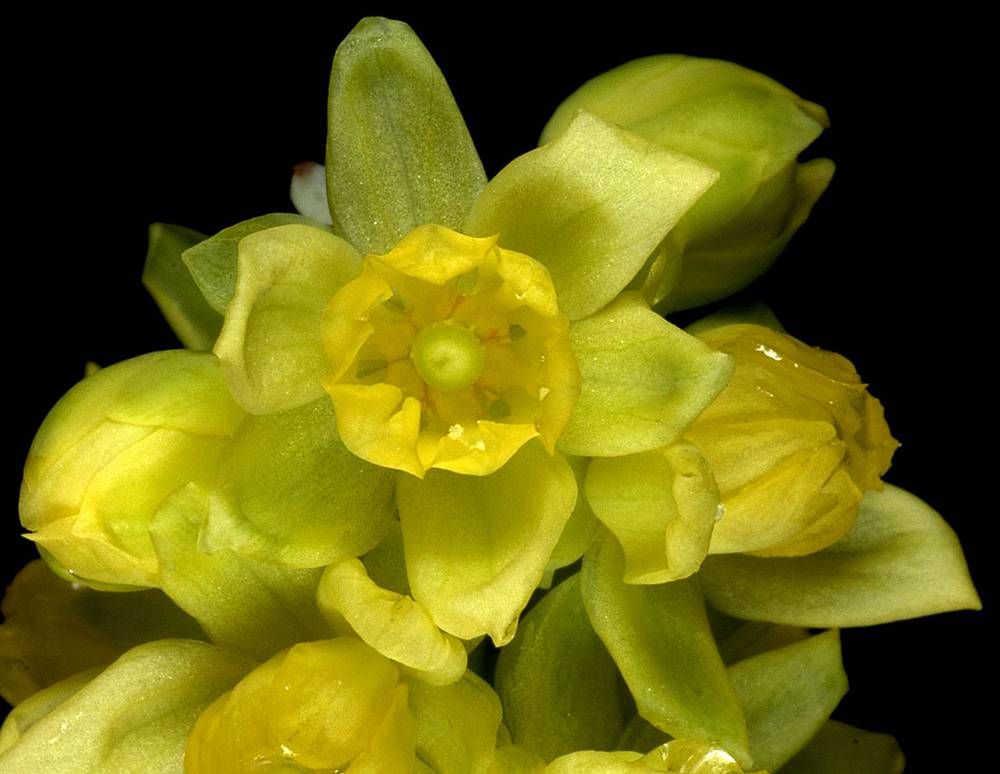Berberis nervosa
Berberidaceae
Cascade Oregon grape
barberry family
monomorphic; without short axillary shoots;
twigs glabrous;
bud scales (13)20–44 mm, persistent;
spines absent.
sometimes spiny.
compound;
leaflets 9–21; thin and ± flexible; smooth but rather dull abaxially; dull and somewhat glaucous adaxially;
terminal leaflet 2.9–8.4 × 1.2–4.8 cm, 1.8–3.2 × as long as wide;
lateral leaflets lance-ovate to ovate, 4–6-veined from base, bases rounded to cordate;
margins plane; each margin with 6–13 teeth 1–2(3) mm, tipped with spines to 1.0–2.4 × 0.1–0.2 mm;
tips acute or broadly acuminate;
petioles 2–11 cm.
basal or alternate; simple or pinnately or ternately compound.
30–70-flowered, 6–17 cm;
bracts acute, obtuse or rounded.
racemes; panicles; umbels, or spikes.
radially symmetric; bisexual, hypogynous;
hypanthium absent, sometimes with 3–9 bractlets forming an epicalyx appressed to calyx;
sepals 6; free, sometimes falling as flowers open, or absent;
petals 6; free; showy, producing nectar, or absent;
stamens 6–18; free and distinct, often same number as petals and opposite them;
anthers opening by apical flaps or longitudinal slits;
pistils 1; superior;
placentation basal or lateral;
styles short or obsolete.
filaments without teeth.
oblong-ovoid or globose, 8–11 mm, blue, glaucous.
berries or capsules.
1–10 per fruit, sometimes bearing an aril.
Berberis nervosa
Berberidaceae
Open or shaded woods, rocky areas. Flowering Mar–Jun. 0–2200 m. BW, Casc, CR, ECas, Est, Sisk, WV. CA, ID, WA; north to British Columbia. Native.
East Africa, Asia, Europe, North America, South America. 15 genera; 3 genera treated in Flora.
The structure of the pistil in Berberidaceae can be confusing, and its homologies are uncertain. Berberidaceae taxa have a single pistil with a single unlobed stigma and an ovary having a single locule. Most taxa have one or a group of basal ovules. A few taxa (including Vancouveria) have more complex pistils, but their structure is difficult to interpret. It is uncertain whether the pistil evolved from a single carpel, like the pistils of Ranunculaceae, or from several fused carpels, as in Papaveraceae (Cronquist 1981).
Alan Whittemore
- Local floras:
BC,
CA,
OR
- Local Web sites:
CalFlora,
CalPhotos,
Flora NW,
PNW Herbaria
WildflowerSearch
iNaturalist (observations)
USDA Plants Database
- LBJ Wildflower Center
- SEINet
- Plants of the World Online
- Encyclopedia of Life
- Wikipedia
- Google Image Search
- Local floras:
CA,
OR
- Local Web sites:
CalFlora,
CalPhotos,
Flora NW,
PNW Herbaria
WildflowerSearch
iNaturalist (observations)
- LBJ Wildflower Center
- SEINet
- Plants of the World Online
- Encyclopedia of Life
- Wikipedia
- Google Image Search



